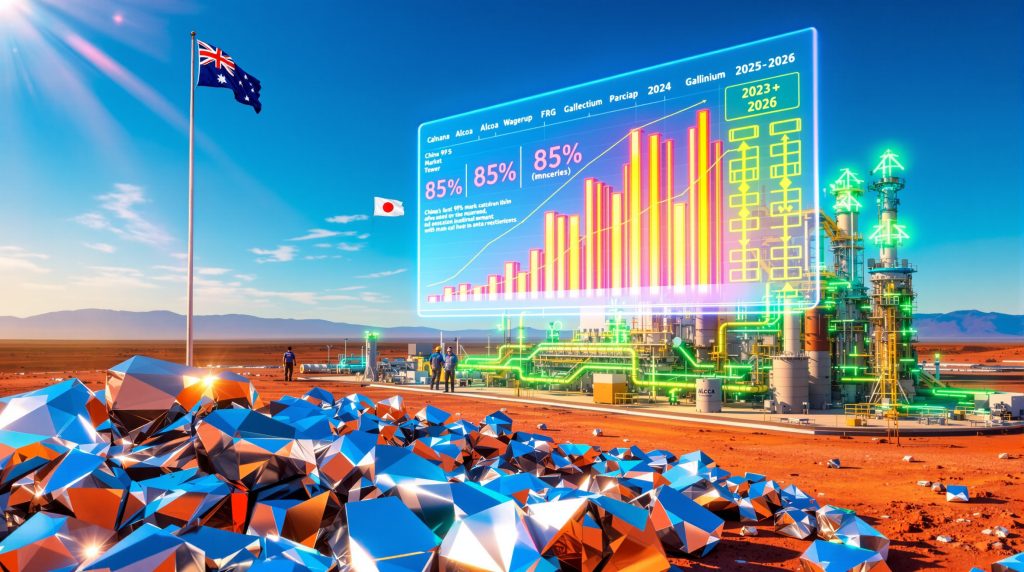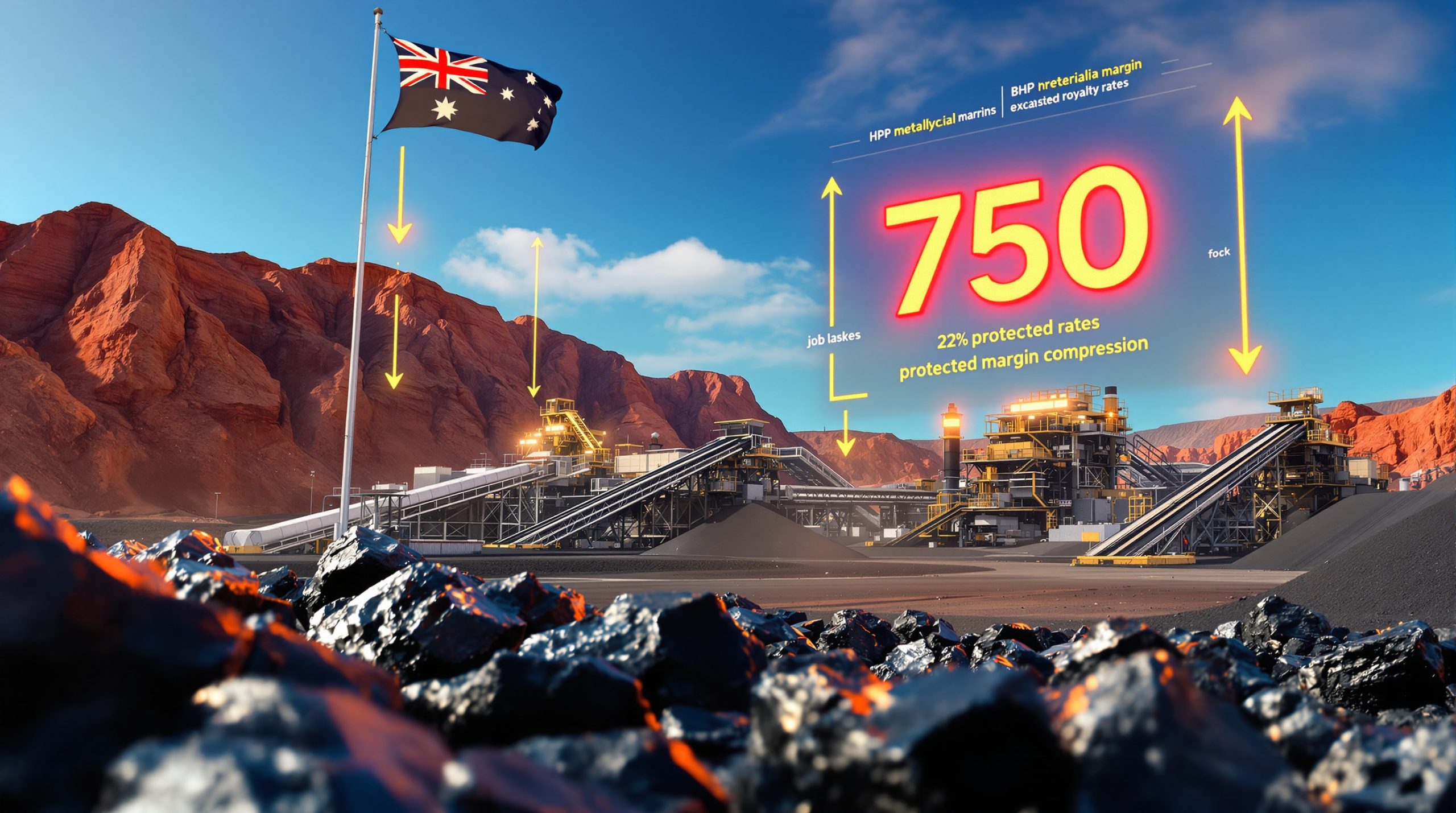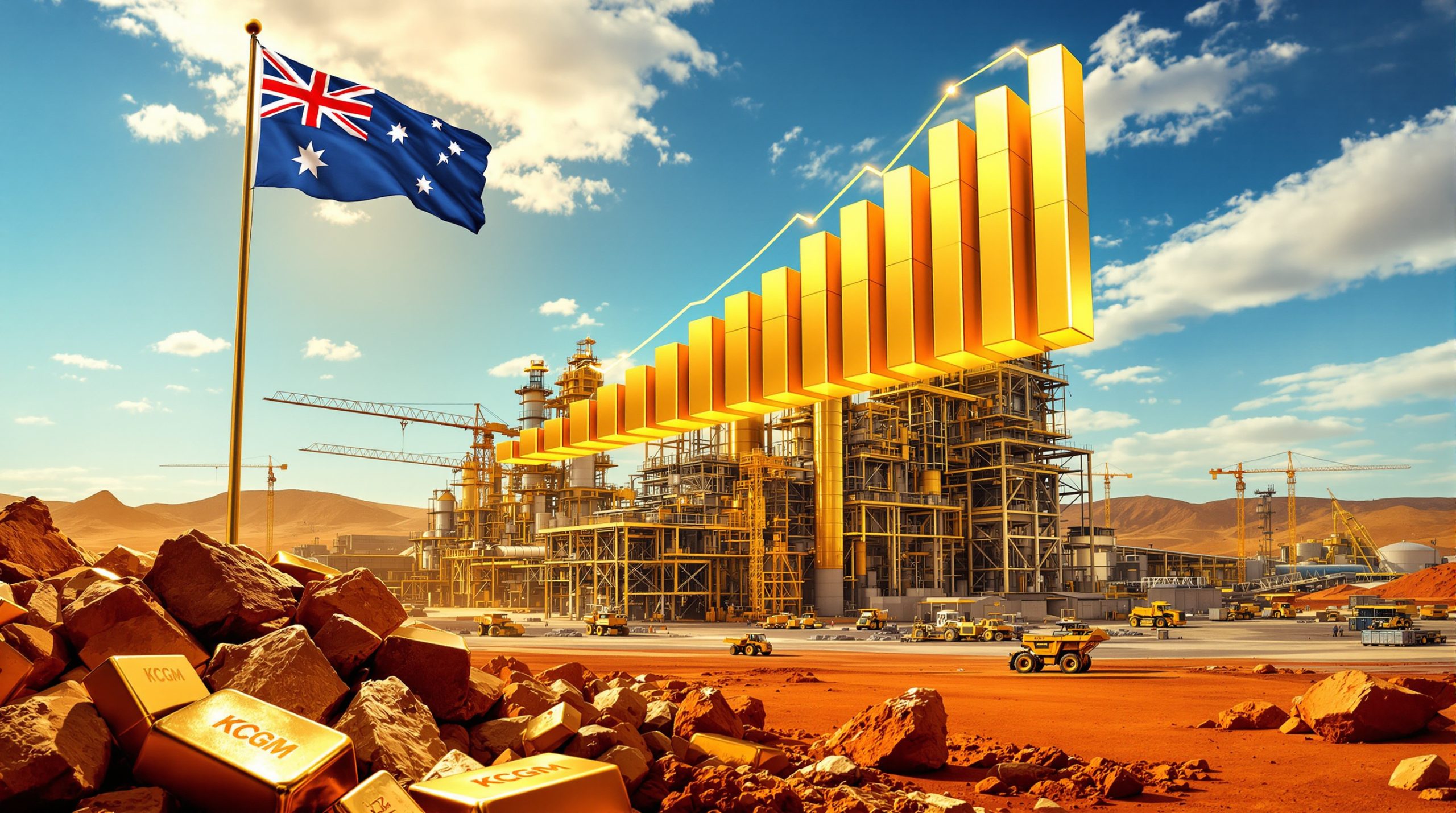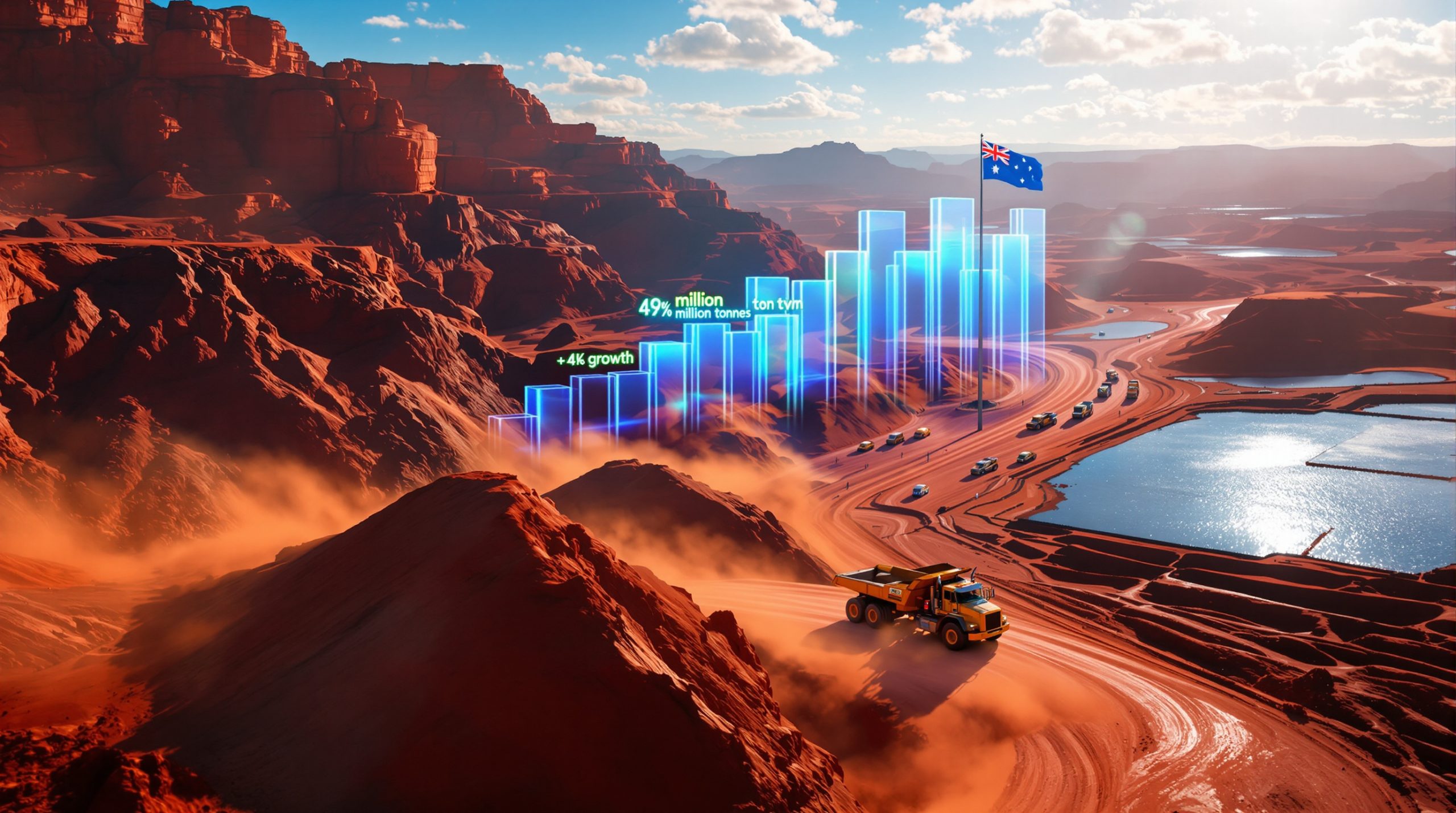The Alcoa gallium project represents a fundamental shift in critical mineral supply chains, addressing decades of Western dependence on Asian production sources. This strategic initiative leverages existing alumina refining infrastructure to extract gallium, a metal essential for advanced semiconductor manufacturing and defense applications. Furthermore, this project aligns with broader energy transition security objectives across allied nations.
Production Capacity and Timeline Projections
Alcoa Corporation's Western Australian facility aims to produce approximately 100 metric tons of gallium annually, with commercial operations expected by the end of 2026 according to CEO William Oplinger's recent statements. This production volume represents roughly 10% of current global demand, establishing a significant non-Chinese supply source for critical technology applications.
The timeline acceleration reflects growing urgency around supply chain security. Unlike traditional mining projects that require years of development, the Alcoa gallium project benefits from existing infrastructure at the Wagerup refinery, reducing typical construction timelines from five years to approximately two years.
| Production Metric | Target Capacity | Timeline |
|---|---|---|
| Annual Output | 100 metric tons | End of 2026 |
| Global Market Share | ~10% | Post-production |
| Infrastructure Status | Existing facility modification | Ongoing |
Strategic Location Advantages at Wagerup
The co-location strategy at Alcoa's existing Wagerup alumina refinery maximises operational efficiency through several key advantages. The facility already possesses the necessary power infrastructure, skilled workforce, and environmental permits required for industrial-scale mineral processing.
This integrated approach reduces capital expenditure by an estimated 60-70% compared to greenfield development, while accelerating project development timelines. The existing Bayer process equipment can be modified to capture gallium that naturally concentrates during aluminium oxide production, creating synergistic value from waste streams.
Western Australia's stable regulatory environment and established mining expertise provide additional operational advantages. The region's proximity to Asian technology markets, combined with reliable shipping infrastructure, positions the facility strategically for global distribution networks. This approach exemplifies effective critical minerals strategy implementation at the operational level.
What International Partnerships Drive the Gallium Project Forward?
The Alcoa gallium project operates through a sophisticated tri-nation partnership structure designed to ensure supply security while sharing investment risks and technological expertise across allied nations.
Japan-Australia Strategic Alliance Structure
The project operates through Japan Australia Gallium Associates (JAGA), combining Japanese government backing with Sojitz Corporation's commercial expertise and trading network capabilities. This partnership model demonstrates how allied nations collaborate on critical mineral security initiatives beyond traditional bilateral trade agreements.
Japanese involvement brings several strategic advantages:
- Advanced purification technology for semiconductor-grade gallium
- Established Asian market relationships for distribution
- Government financial backing through strategic mineral initiatives
- Technical expertise in gallium processing and quality control
The partnership structure allocates production volumes based on investment contributions, ensuring Japan receives preferential access to gallium supplies for its domestic semiconductor and electronics industries. However, this differs from standalone raw materials facility developments which typically focus on single-nation control.
US Government Support and Strategic Implications
American governmental involvement through proposed special purpose vehicle (SPV) structures highlights gallium's classification as a defence-critical material under current national security frameworks. The U.S. Department of Defense has identified gallium as essential for radar systems, satellite communications, and advanced weaponry.
This tri-nation cooperation framework establishes important precedents for future critical mineral partnerships among democratic allies. The structure provides a template for similar initiatives involving lithium, rare earth elements, and other strategically important materials.
Strategic Significance: The partnership demonstrates how Western allies can coordinate resource security without relying on potentially hostile nations for critical materials essential to defence and technology sectors.
Why Has Gallium Become a Geopolitical Priority?
Gallium's transformation from a relatively obscure metal to a geopolitical flashpoint reflects the intersection of technological advancement, supply concentration, and international tensions around critical material access.
China's Market Dominance and Export Restrictions
Chinese producers currently control approximately 95% of global gallium production, creating severe supply vulnerabilities for Western technology manufacturers. This dominance stems from China's large-scale aluminium production, which generates gallium as a byproduct, combined with government subsidies supporting domestic processing capabilities.
Recent export control implementations by Chinese authorities have accelerated international efforts to establish alternative production sources. These restrictions, implemented in 2023 and expanded in 2024, require special licences for gallium exports and have created supply shortages for Western manufacturers.
| Supply Chain Metric | Current Status | Post-Alcoa Impact |
|---|---|---|
| Chinese Market Share | 95% | ~85% |
| Western Production Capacity | <5% | ~15% |
| Supply Security Risk | Critical | Moderate |
| Price Volatility | High | Reduced |
The concentration of gallium production in China creates multiple vulnerability points. Political tensions, trade disputes, natural disasters, or domestic policy changes can immediately disrupt global technology supply chains. In addition, this situation differs significantly from other strategic resource developments, such as Greenland minerals importance where alternative sources remain theoretical rather than operational.
Semiconductor Industry Dependency Concerns
Gallium arsenide compounds enable high-frequency electronics, 5G infrastructure, and military radar systems essential for modern defence capabilities. The compound's superior electron mobility compared to silicon makes it irreplaceable for specific applications requiring high-speed signal processing.
Key applications driving gallium demand include:
- 5G base stations requiring high-frequency amplifiers
- Satellite communications systems for both civilian and military use
- Advanced radar systems for air defence and weather monitoring
- Electric vehicle charging infrastructure using gallium nitride components
- LED lighting systems for energy-efficient illumination
Supply disruptions could significantly impact telecommunications advancement and national security capabilities across allied nations. The semiconductor industry's just-in-time manufacturing model provides minimal buffer inventory, making supply security particularly critical.
What Are the Technical Specifications of Alcoa's Gallium Extraction Process?
The Alcoa gallium project employs sophisticated extraction techniques that leverage existing alumina refining infrastructure while meeting stringent purity requirements for semiconductor applications.
Alumina Refinery Integration Methodology
The extraction process utilises existing Bayer process infrastructure, where gallium naturally concentrates during aluminium oxide production. Gallium oxide concentrates in the sodium aluminate solution at approximately 150-200 parts per million, requiring specialised separation techniques to achieve commercial concentrations.
The process involves several key stages:
- Initial concentration from alumina processing liquor
- Chemical precipitation using specialised reagents
- Purification cycles to remove aluminium and sodium impurities
- Electrochemical reduction to produce metallic gallium
- Final purification to achieve semiconductor-grade specifications
This synergistic approach maximises resource utilisation while minimising environmental footprint expansion. The process recovers gallium that would otherwise remain in waste streams, creating additional revenue from existing operations.
Quality Standards and Purity Requirements
Commercial gallium production requires 99.99% minimum purity for semiconductor applications, with ultra-high purity grades reaching 99.9999% for specialised defence applications. The Alcoa facility targets 99.999% purity as its standard product specification.
Technical specifications include strict limits on metallic impurities:
- Aluminium content: <10 parts per million
- Iron content: <5 parts per million
- Silicon content: <3 parts per million
- Copper content: <2 parts per million
Quality control systems employ inductively coupled plasma mass spectrometry (ICP-MS) and other advanced analytical techniques to ensure consistent product specifications meeting international standards for electronic-grade gallium.
How Does the Project Impact Investment Opportunities?
The Alcoa gallium project creates multiple investment vectors across the critical minerals sector while demonstrating how traditional industrial companies can diversify into high-value specialty materials.
Capital Investment Requirements and Funding Sources
The project requires substantial capital investment estimated between $150-200 million for specialised extraction equipment, facility modifications, and quality control infrastructure. This investment level reflects the sophisticated processing requirements for semiconductor-grade gallium production.
Government backing from three nations provides financial stability and reduces investment risk profiles for stakeholders. The tri-nation support structure includes:
- Direct government investment through strategic mineral funds
- Loan guarantees reducing financing costs
- Tax incentives for critical mineral production
- Research and development grants for process optimisation
The diversified funding approach reduces dependence on traditional mining project financing while ensuring project completion despite market volatility. Furthermore, this contrasts with recent trade policy impacts, such as aluminium tariff effects, which create uncertainty rather than stability.
Market Pricing Dynamics and Revenue Projections
Gallium prices have experienced significant volatility due to supply constraints, with pricing ranging from $300-800 per kilogram depending on purity grades and market conditions. The Alcoa gallium project could capture premium pricing for non-Chinese sources, potentially commanding 10-20% price premiums over Chinese-supplied material.
Revenue projections based on current market conditions suggest annual revenue potential of $40-80 million from 100 metric tons of production, depending on pricing realisation and product mix. Premium grades for defence applications could generate significantly higher margins.
Investment Consideration: The tri-nation governmental support structure significantly reduces political and regulatory risks typically associated with critical mineral projects while providing stable demand through government purchasing commitments.
What Regulatory and Environmental Considerations Shape the Project?
The Alcoa gallium project navigates complex regulatory frameworks spanning mining, chemical processing, and export control regulations across three nations with varying environmental and safety standards.
Environmental Impact Assessment Requirements
The co-location strategy minimises additional environmental disturbance by utilising existing industrial infrastructure at the Wagerup refinery. Environmental assessments focus on process modifications rather than greenfield development impacts, significantly reducing regulatory approval timelines.
Key environmental considerations include:
- Water usage optimisation through closed-loop processing systems
- Chemical handling protocols for gallium extraction reagents
- Waste stream management for extraction residues
- Air emission controls during high-temperature processing
The project benefits from existing environmental permits and monitoring systems already in place for alumina refining operations, reducing regulatory complexity and approval timelines.
International Trade Compliance Framework
The project must navigate complex international trade regulations, export licensing requirements, and strategic material classification systems across three participating nations. Gallium's designation as a critical material triggers additional compliance requirements for export documentation and end-user verification.
Regulatory frameworks include:
- Australian strategic goods controls for critical mineral exports
- U.S. export administration regulations for defence-related materials
- Japanese import procedures for strategic materials
- OECD guidelines for responsible mineral sourcing
The tri-nation partnership structure provides regulatory coordination mechanisms to streamline compliance while ensuring appropriate security controls for strategic material distribution.
When Will Commercial Production Begin and What Are the Key Milestones?
The Alcoa gallium project follows an accelerated development timeline leveraging existing infrastructure to achieve commercial production within two years of project announcement.
2025-2026 Development Timeline
According to Alcoa CEO William Oplinger's recent statements, the project targets commercial production by the end of 2026, with several critical milestones throughout 2025 and 2026. According to Alcoa's official announcement, this timeline represents an unprecedented acceleration for critical mineral project development.
2025 Milestones:
- Q4 2025: Final feasibility studies completion and regulatory approvals
- Q4 2025: Equipment procurement and engineering finalisation
- Q4 2025: Construction commencement for specialised processing areas
2026 Milestones:
- Q2 2026: Equipment installation and commissioning phases
- Q3 2026: Process optimisation and quality testing
- Q4 2026: Commercial production commencement
The accelerated timeline reflects urgency around supply chain security and the availability of existing infrastructure that reduces typical construction requirements.
Production Scaling and Future Expansion Potential
Initial production targets 100 metric tons annually, with potential for capacity expansion based on market demand and geopolitical developments. The modular design enables future scaling without major infrastructure overhauls, potentially doubling capacity to 200 metric tons with additional investment.
Expansion considerations include:
- Market demand growth from 5G infrastructure deployment
- Defence procurement increases for advanced radar systems
- Electric vehicle adoption driving gallium nitride component demand
- Geopolitical developments affecting Chinese supply availability
The facility design incorporates expansion capabilities that could accommodate increased production within the existing site footprint, providing flexibility for future market developments.
How Does This Project Position Australia in Global Critical Minerals Markets?
The Alcoa gallium project establishes Australia as a comprehensive critical minerals supplier while demonstrating advanced processing capabilities beyond traditional raw material exports.
Strategic Resource Diversification Benefits
Australia's emergence as a gallium producer complements existing lithium, rare earth, and cobalt mining capabilities, establishing the nation as a comprehensive critical minerals supplier for allied technology industries. This diversification reduces global dependence on single-source suppliers while creating strategic partnerships with major technology consumers.
The project demonstrates Australia's capacity for value-added mineral processing rather than raw material exports. This shift toward downstream processing creates higher-value employment and captures greater economic value from domestic mineral resources.
Key strategic advantages include:
- Diversified critical mineral portfolio spanning multiple technology sectors
- Advanced processing capabilities for high-value specialty materials
- Stable regulatory environment supporting long-term investment
- Strategic location between Asian markets and Western allies
Economic Impact on Western Australian Mining Sector
The project creates high-skilled employment opportunities in chemical processing, quality control, and specialised equipment operations while demonstrating advanced mineral processing capabilities. This technological advancement positions Western Australia for additional critical mineral processing investments.
Economic benefits extend beyond direct employment to include:
- Technology transfer in advanced mineral processing techniques
- Supply chain development for specialised equipment and services
- Research partnerships with universities and technology institutes
- Export revenue diversification beyond traditional bulk commodities
The project establishes precedents for future critical mineral processing facilities, potentially attracting additional investment in lithium processing, rare earth separation, and other high-value mineral processing operations. Additionally, as reported by Reuters, the $2 billion investment commitment demonstrates unprecedented international cooperation in critical minerals development.
What Challenges and Risks Could Impact Project Success?
Despite strong governmental support and strategic importance, the Alcoa gallium project faces several technical, market, and operational challenges that could impact successful commercialisation.
Technical and Operational Risk Factors
Gallium extraction requires precise process control and specialised expertise not commonly available in traditional aluminium refining operations. Technical challenges include maintaining consistent purity levels while optimising extraction efficiency from alumina processing streams.
Key operational risks include:
- Process optimisation difficulties achieving target extraction rates
- Quality control challenges meeting semiconductor-grade specifications
- Equipment reliability issues with specialised purification systems
- Skilled workforce availability for advanced chemical processing operations
The integration of gallium extraction with existing alumina refining operations creates potential operational conflicts if processing optimisation for one product negatively impacts the other.
Market Competition and Pricing Pressures
Chinese producers could respond with aggressive pricing strategies or increased production to maintain market dominance, potentially undermining project economics. The concentrated nature of gallium demand among a limited number of large technology companies creates customer concentration risks.
Market challenges include:
- Price volatility from supply-demand imbalances
- Customer concentration among major technology manufacturers
- Technology substitution potentially reducing gallium demand
- Chinese competitive response through pricing or supply increases
Project economics must account for potential price volatility and competitive responses while maintaining sufficient margins to justify continued operation during market downturns.
Disclaimer: This analysis contains forward-looking statements regarding production timelines, market conditions, and financial projections that involve inherent uncertainties and risks. Actual results may differ materially from projections due to market conditions, technical challenges, regulatory changes, or geopolitical developments.
Alcoa's Gallium Initiative: Reshaping Critical Mineral Supply Chains
The Alcoa gallium project represents more than a single mining operation. This initiative embodies a strategic transformation toward critical mineral supply chain resilience among democratic allies, demonstrating how traditional industrial companies can adapt to evolving geopolitical realities.
The project's success could catalyse additional critical mineral diversification efforts while reducing Western dependence on geopolitically unstable supply sources. By leveraging existing infrastructure and tri-nation partnerships, Alcoa demonstrates an efficient model for rapid critical mineral capacity development.
The end-of-2026 production timeline positions the project to capture growing gallium demand driven by 5G infrastructure expansion, electric vehicle adoption, and defence modernisation programmes. This timing advantage, combined with governmental support and strategic partnerships, creates compelling foundations for long-term success in the evolving critical minerals landscape.
The broader implications extend beyond gallium supply security to establish frameworks for international cooperation on critical mineral projects. As technological advancement continues accelerating demand for specialised materials, the Alcoa model provides a template for allied nations seeking supply chain independence from potentially hostile suppliers.
This analysis is provided for educational purposes only and should not be construed as investment advice. Readers should conduct their own research and consult qualified professionals before making investment decisions related to critical minerals or mining companies.
Looking for Your Next Critical Minerals Investment Opportunity?
Discovery Alert's proprietary Discovery IQ model delivers real-time alerts on significant ASX mineral discoveries, instantly empowering subscribers to identify actionable opportunities ahead of the broader market. Understand why major mineral discoveries can lead to substantial market returns by exploring Discovery Alert's dedicated discoveries page, showcasing historic examples of exceptional outcomes, and begin your 30-day free trial today to position yourself ahead of the market.




